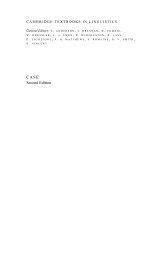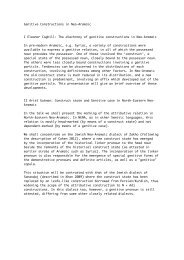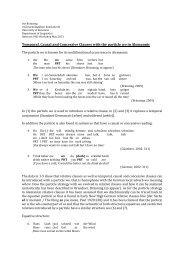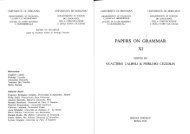Sebastian Sulger (Konstanz): Genitive subjects in Hindi-Urdu
Sebastian Sulger (Konstanz): Genitive subjects in Hindi-Urdu
Sebastian Sulger (Konstanz): Genitive subjects in Hindi-Urdu
Create successful ePaper yourself
Turn your PDF publications into a flip-book with our unique Google optimized e-Paper software.
Semantically, the genitive phrases are not conf<strong>in</strong>ed to possession, but may realize different relations<br />
between the nom<strong>in</strong>als (cf. Barker 1995, Chisarik & Payne 2001). Among them, <strong>in</strong> H<strong>in</strong>di/<strong>Urdu</strong>, are<br />
attribution (6a) and quality (6b) relations. Therefore, they are argued to l<strong>in</strong>k to unrestricted functions <strong>in</strong><br />
the sense that they may realize a variety of different thematic roles.<br />
I implement the analysis of H<strong>in</strong>di/<strong>Urdu</strong> PCCs <strong>in</strong> the theoretical framework of Lexical-Functional<br />
Grammar (LFG, Dalrymple 2001). The copula is an <strong>in</strong>transitive verb select<strong>in</strong>g a s<strong>in</strong>gle thematic role,<br />
a theme, <strong>in</strong> its argument structure. This theme is l<strong>in</strong>ked to the subject function of the ma<strong>in</strong> clause as<br />
per the subject condition (Dalrymple 2001, Bresnan 2001). When a possessor is realized, an additional<br />
“theme” role is selected by the theme via a lexical process; this “<strong>in</strong>ternal” theme is l<strong>in</strong>ked to the subject<br />
function <strong>in</strong>side the ma<strong>in</strong> clause’s subject (see (7) and the result<strong>in</strong>g functional structure <strong>in</strong> (8)). In LFG, the<br />
SUBJ function is taken to be both discourse-oriented and unrestricted, reflect<strong>in</strong>g the two salient properties<br />
of the H<strong>in</strong>di-<strong>Urdu</strong> genitive discussed above. The agreement between the possessor and the possessum can<br />
then be taken care of by standard LFG techniques. In sum, the analysis I propose expla<strong>in</strong>s the facts <strong>in</strong> a<br />
more natural manner and readily presents an explanation for the agreement patterns and semantic effects<br />
observed.<br />
(1) a. nadya=ka/*=ki mAkan hE<br />
Nadya.F.Sg.Obl=Gen.M.Sg.Nom/*=Gen.F.Sg.Nom house.M.Sg.Nom be.Pres.3P.Sg<br />
lit. ‘There is a house of Nadya’s.’ = ‘Nadya has/owns a house.’<br />
b. nadya=ki/*=ka Almari hE<br />
Nadya.F.Sg.Obl=Gen.F.Sg.Nom/*=Gen.M.Sg.Nom cupboard.F.Sg.Nom be.Pres.3P.Sg<br />
lit. ‘There is a cupboard of Nadya’s.’ = ‘Nadya has/owns a cupboard.’<br />
(2) ram=ka g h Ar laut.-ne=ka vIcar<br />
Ram.M.Sg.Obl=Gen.M.Sg.Nom home.M.Sg.Nom return-Inf.M.Sg.Obl thought.M.Sg.Nom<br />
t h -a<br />
be.Past-M.Sg<br />
‘Ram was th<strong>in</strong>k<strong>in</strong>g of return<strong>in</strong>g home.’ Mohanan (1994), p. 180<br />
(3) [[nadya=ka]GEN mAkan]SUBJ hE<br />
(4) a. xUda hE<br />
god.M.Sg.Nom be.Pres.3P.Sg<br />
‘There is a god.’<br />
b. pArti hE<br />
party.M.Sg.Nom be.Pres.3P.Sg<br />
‘There is a party.’<br />
(5) ram=ke Apna ek b h i b�t.a nAhĩ t h -a<br />
Ram.M.Sg.Obl=Gen.M.Sg.Obl self.M.Sg.Nom one even son.M.Sg.Nom not be.Past-M.Sg<br />
lit. ‘There was not even one son of Ram’s own.’ = ‘Ram didn’t have even one son of his own.’<br />
Mohanan (1994), p. 181<br />
(6) a. lahor=ka Sehr<br />
Lahore=Gen.M.Sg.Nom city.M.Sg.Nom<br />
‘the city of Lahore’<br />
b. xof=ka lAmha<br />
fear.M.Sg.Nom=Gen.M.Sg.Nom moment.M.Sg.Nom<br />
‘moment of fear’







